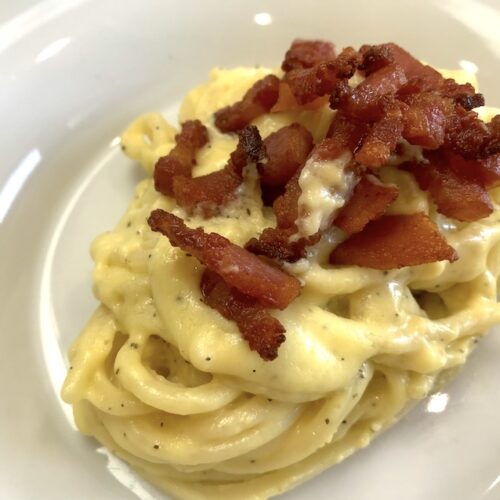OMG Carbonara!! The holy grail of easy but not easy Italian dish, and oh boy is there a lot of debate on how this dish should be made.
So here’s the deal, carbonara has very few ingredients. And like anything that has few ingredients, each ingredient becomes extremely important and subject to a lot of discussion and debate. Let’s take a look at some of these, starting with the elephant in the room – CREAM!
- Cream or no cream … alas, it’s like the debate between good and evil. Carbonara in Rome (where carbonara is from) does not have cream in it. So as a carbonara “purist”, I vote no cream. In fact, to a carbonara purist, this isn’t even a debatable point. So why then, would cream even be part of this discussion you might ask. Well, the answer is simple – carbonara is a “creamy” dish and the easiest way to make something “creamy” is to add cream. Not only that, it makes the sauce a lot more forgiving overall, giving your eggs a better chance of not scrambling. It also helps buy time between when the dish is ready to serve and when you actually sit down to eat it. Carbonara is a dish meant to be eaten IMMEDIATELY when it is done. Because the sauce is dense and rich, it will become “gluggy” when cold – so adding cream helps you (or the chef) buy some time.
Now that we have that out of the way, let’s look at the other important but perhaps less debated points.
- Bacon anyone? Carbonara is traditionally made with guanciale, or cured pork cheek, which may not be easy to find depending on where you live and the access you have to an Italian grocer or deli. You can substitute guanciale with pancetta, which is cured pork belly, so close enough. Get your butcher or deli guy to slice it thick (like 1/4 inch thickness or more), then you can cut into strips or cubes yourself at home. If you can’t get pancetta, then bacon works too; keep in mind bacon is smoked, so it will give carbonara a different taste than what one might get in Rome. But since bacon is my Achilles heel, I won’t poo-poo it, even as a purist. You got bacon? Use it, it’s dang good.
- Parmesan or Pecorino? This one doesn’t have a strict rule. Pecorino is the traditional cheese (it as a stronger, saltier flavor), but you can use whatever you can find, or a combination of the two. Most important point is to use the best quality cheese you have available to you (so walk right past that Kraft parmesan cheese in the grocery store aisle); remember, few ingredients means everything counts!
- Pasta type. This is about what vehicle is best for the sauce, and honestly, spaghetti is great for this. You can try different types of pasta here, but sometimes old school is best. The only important thing is that fresh pasta does not work well, so go with the store bought dried pasta, and save yourself a few dollars (which you will need for the guanciale 😛 )
The only other two ingredient to talk about is pasta water – use it to help thin out your sauce to get the creamy consistency and texture you like. And the rendered oil (fat) from the guanciale or pancetta or bacon is the key to dish and plays a huge role in the emulsification process that gives carbonara the texture and creaminess (without cream).
While the ingredients list is short, and TV chefs make it look easy, I would say this is one of the hardest dishes to make well. Try ordering carbonara at various restaurants and you’ll see the difference in each dish – even trained chefs make bad carbonara. Regardless, it’s kinda fun to make, and since my step-kids keep asking me to make it, I’ve had a lot of chances to practice 😀 (thanks kids!)
This dish is all about technique, which can take a few attempts to master. Even the techniques vary far and wide and we can keep going with this post, but I’d rather you go and try to make this and let me know how it went. The recipe and technique I am sharing here is inspired by Sarah Cicolini, a new young chef in Rome who is getting a lot of press and recognition for her Carbonara, among other Italian dishes. Look her up, she’s super.

Spaghetti Carbonara
Print Pin RateEquipment
- metal bowl
- whisk
Ingredients
- 3 large eggs (1 egg + 2 egg yolk), see notes
- 1-1½ cup grated pecorino romano cheese (100-150g ), see notes
- 200 g guanciale (about 7 oz), cut in cubes or strips, see notes
- 200 g spaghetti (about 1/2 lb)
- pepper
- pasta water
How I Make It
Guanciale (or pancetta or bacon)
- Chop the guanciale (or bacon or pancetta) into cubes or strips. Pieces will shrink a little after you cook them, so don't cut too small.
- Starting in a cold pan, cook the guanciale until browned, and the fat has rendered out. Depending on how much fat you trimmed off, or how fatty the cut you're using is, you may need to add a little olive oil to make sure there's enough oil for this dish. You will need about 4 tablespoons (1/4 cup) of oil. If using bacon, this usally isn't a problem as bacon renders out a lot of fat. Remove the guanciale from the oil when cooked to your liking, and set aside. Reserve the oil.
Egg-cheese mixture
- In a metal bowl, whisk together egg, egg yolk, cheese, and pepper.
- Pour about 1-2 tablespoon of the reserved oil into the mixture, and whisk to combine.
- Boil a pot of water and place the mixture over the steam. Use kitchen mits or towel to hold the bowl with one hand, and use the other hand to whisk the mixture vigorously for about 30-60 seconds, until the mixture is smooth and silky. You can do this over the pot of pasta while it is cooking (becareful your pasta doesn't boil over under your bowl) or over a separate pot of water (which might be less stressful).This emulsification process will start cook the eggs and melt the cheese, helping to prevent "scrambled eggs" in your pasta later. If the sauce is too thick, add a little pasta cooking water a little bit at a time (slowly! so your eggs don't scramble), and keep whisking vigorously.
Cook pasta until just before al dente
- When the water is boiling, add spaghetti and follow cooking time as instructed on the box. Cook the pasta until just before al dente.
- Just before time to remove the pasta, warm up a couple of tablespoons of the reserved oil on low/low-medium heat - we're not looking for frying temperature.
- When the pasta is almost al dente, pull it from the water and add directly to the oil. It's ok if some water comes with it. Working quickly, stir the pasta vigorously for about 3 minutes in the oil to emulsify the fat. Add a little more pasta water if it is too dry. The water & oil will turn into a milky-looking emulsification. This is good and will be the basis of your sauce so continue until you achieve the consistency you like (don't go nuts though or your end result will be too watery!).
- Turn off the heat. Add the egg-cheese sauce and mix through, continuously mixing and tossing. Be attentive, work quickly, and keep it moving or you might get that undesirable "scrambled egg" texture. If the sauce feels a little dry, add a little more pasta water until you have the consistency you like.Taste & adjust for salt and pepper.
- Top the finished pasta with the guanciale pieces and a little more cheese if desired.
- Serve and eat IMMEDIATELY. This is not a dish you save for later. Leftovers will not be as good!
Notes
- Try to get grated Pecorino Romano, instead of shaved or shredded. It will incorporate easier in the sauce. Delis that sell cheeses will usually grate it for you. I've included the weight (150g) as well since 1 1/2 cup of cheese can translator to a different amount if it is shaved or shredded.
- You can use parmesan as a substitute for pecorino, it will taste a little different, but still good. You can also do a combination of both. Always use high quality cheese whichever one you choose.
- Guanciale can be found in Italian delis, but if you can't get Guanciale, you can substitute with pancetta. Bacon will also work, but since bacon is smoked, it will taste different than the 'traditional' carbonara.
- You will need oil from the cooked Guanciale or pancetta - depending on how fat the cut you have comes with, and how much fat you've trimmed off, you may need to add a little olive oil to ensure you have enough oil to complete this dish.

